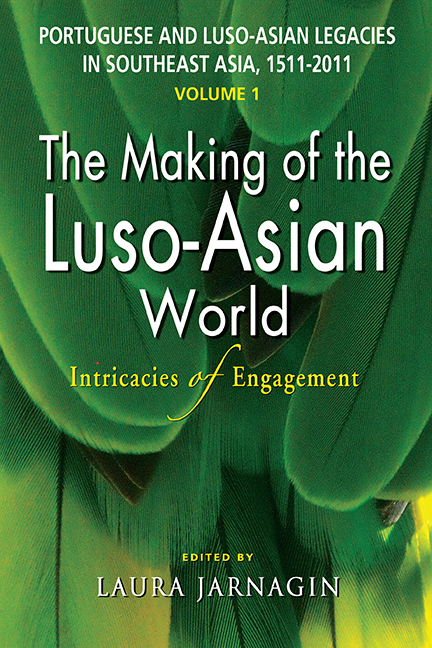 Portuguese and Luso-Asian Legacies in Southeast Asia, 1511–2011, vol. 1
Portuguese and Luso-Asian Legacies in Southeast Asia, 1511–2011, vol. 1 Book contents
- Frontmatter
- Contents
- List of Charts, Figures and Tables
- A Tribute to Glenn Ames
- Preface
- List of Contributors
- Glossary
- Introduction: Towards Clarity through Complexity
- Part One Adaptations and Transitions in the South and Southeast Asian Theatres, Sixteenth through Eighteenth Centuries
- 1 Supplying Simples for the Royal Hospital: An Indo-Portuguese Medicinal Garden in Goa (1520–1830)
- 2 Malacca in the Era of Viceroy Linhares (1629–35)
- 3 From Meliapor to Mylapore, 1662–1749: The Portuguese Presence in São Tomé between the Qutb Shāhī Conquest and Its Incorporation into British Madras
- 4 Eighteenth-Century Diplomatic Relations between Portuguese Macao and Ayutthaya: The 1721 Debt Repayment Embassy from Macao
- 5 Continuities in Bengal's Contact with the Portuguese and Its Legacy: A Community's Future Engangled with the Past
- Part Two Dispersion, Mobility and Demography from the Sixteenth into the Twenty-first Centuries
- Part Three Mixed Legacies: The Portuguese and Luso-Asians in the Twentieth and Twenty-first Centuries
- Bibliography
- Index
3 - From Meliapor to Mylapore, 1662–1749: The Portuguese Presence in São Tomé between the Qutb Shāhī Conquest and Its Incorporation into British Madras
from Part One - Adaptations and Transitions in the South and Southeast Asian Theatres, Sixteenth through Eighteenth Centuries
Published online by Cambridge University Press: 21 October 2015
- Frontmatter
- Contents
- List of Charts, Figures and Tables
- A Tribute to Glenn Ames
- Preface
- List of Contributors
- Glossary
- Introduction: Towards Clarity through Complexity
- Part One Adaptations and Transitions in the South and Southeast Asian Theatres, Sixteenth through Eighteenth Centuries
- 1 Supplying Simples for the Royal Hospital: An Indo-Portuguese Medicinal Garden in Goa (1520–1830)
- 2 Malacca in the Era of Viceroy Linhares (1629–35)
- 3 From Meliapor to Mylapore, 1662–1749: The Portuguese Presence in São Tomé between the Qutb Shāhī Conquest and Its Incorporation into British Madras
- 4 Eighteenth-Century Diplomatic Relations between Portuguese Macao and Ayutthaya: The 1721 Debt Repayment Embassy from Macao
- 5 Continuities in Bengal's Contact with the Portuguese and Its Legacy: A Community's Future Engangled with the Past
- Part Two Dispersion, Mobility and Demography from the Sixteenth into the Twenty-first Centuries
- Part Three Mixed Legacies: The Portuguese and Luso-Asians in the Twentieth and Twenty-first Centuries
- Bibliography
- Index
Summary
Along the seashore of Chennai, the capital of Tamil Nadu state, known previously as Madras, runs the Santhome Highway. It links Marina Beach in the north, a highly popular sightseeing attraction and a place of socialization in the Tamil metropole, with the Adyar area in the south, where the headquarters of the Theosophical Society and its renowned library are. Between these two landmarks is placed Santhome Cathedral, the centre of Catholic life in Chennai.
The toponym “Santhome” is probably the most visible legacy of the ancient Portuguese settlement of Sao Tome (originally “Thome”, and hence today's toponym “Santhome”) de Meliapor. What used to be a fortress that preceded and then competed with the English Fort St George is now only a borough in the Tamil capital. However, it is remarkable that the Portuguese settlement had a compound denomination: Sao Tome de Meliapor. Before the advent of the Lusitans there had already been an Indian town today called Mylapore (originally “Mailapur”), or the “city of the peacocks”. Archaeological excavations in Mylapore demonstrate that the city was already an important trading post in the second century and that around the seventh century it counted at least a śaivite, a vaisnavite, and a jaina temple.
The purpose of this chapter is to propose some preliminary lines of research that may allow us to understand the strategies of resilience of the Portuguese in Sao Tome de Meliapor between its conquest in 1662 by the Qutb Shahi dynasty of Golconda and its incorporation into British Madras in 1749. By examining archival documents kept in Goa and Lisbon, it will be possible to see better how an autonomous Portuguese community, perfectly exemplifying what has been defined the “shadow empire”, persisted in a corner of the Coromandel Coast, blessed by the memory of the Apostle Thomas and still considered economically viable.
RELIQUARY CITY OR A PORTUGUESE RELIC?
Ines Županov has explored how the “discovery” in 1517 of the sepulchre of Saint Thomas in Mylapore made possible the creation of a “factory settlement of independent merchants”.
- Type
- Chapter
- Information
- Portuguese and Luso-Asian Legacies in Southeast Asia, 1511–2011, vol. 1The Making of the Luso-Asian World: Intricacies of Engagement, pp. 67 - 82Publisher: ISEAS–Yusof Ishak InstitutePrint publication year: 2011


